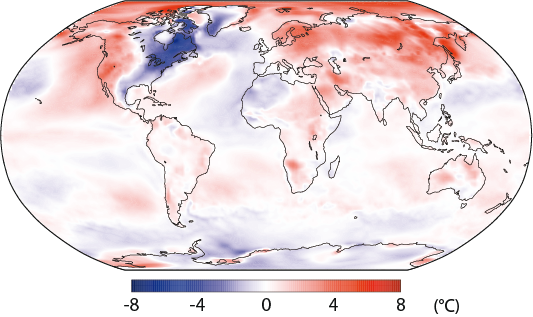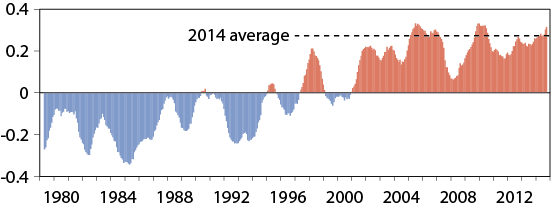

Global temperatures continued to be high in the first quarter of this year after 2014 was one of the warmest years on record. ECMWF data for January to March 2015 show anomalously warm conditions over much of Europe, Asia, the eastern North Pacific, western North America and the Arctic Ocean.
The data are based on observations from weather stations, aircraft, satellites and many other sources, which are reanalysed using ECMWF’s global forecast model. The resulting dataset, called ERA-Interim, provides a comprehensive, consistent and up-to-date record of the global climate since 1979. Inevitably, the data also carry a degree of uncertainty.
In ERA-Interim, the warmth of the opening months of 2015 has been sufficient for the 12-month global mean that ends in March to be higher than for nearly all preceding 12-month means. Only 2005 and 2009/10 saw 12-month periods with higher average global temperatures. Differences in these peak values are within the range of uncertainty: other commonly used datasets show slightly lower values for the earlier periods.
Meanwhile, the US National Snow and Ice Data Center reported that its lowest recorded winter-maximum Arctic sea-ice extent occurred in late February. Below-average sea ice and associated above-average temperatures for the season were prominent over the Bering and Okhotsk Seas. In contrast, eastern North America was anomalously cold.

Differences between two-metre temperature for January–March 2015 and the 1981–2010 average for the quarter, based on the ERA-Interim reanalysis
Further south, it was relatively warm over much of the tropical Pacific and Indian Oceans and southern subtropics. Colder-than-usual conditions around Antarctica appear to have continued into 2015. Here, winter sea ice reached record extent and surrounding open-ocean temperatures were below average in 2014.
Warm 2014
The warm start to 2015 follows exceptionally warm conditions globally in 2014. ERA-Interim agrees with other datasets that 2014 was one of the warmest years on record.

Twelve-month running-mean anomalies relative to 1981–2010 in global-mean surface temperature from the ERA-Interim reanalysis
The longer-term picture is also similar for different datasets: warming since the 1970s is not in doubt, nor is the occurrence of warmer and colder spells linked with El Niño events, volcanic eruptions or other sources of variability.
With the prospect of a strengthening El Niño, but with uncertainty for the second half of the year, it seems quite likely but not certain that global temperatures as recorded in ERA-Interim will reach their highest values yet during 2015.
